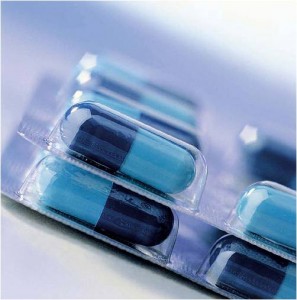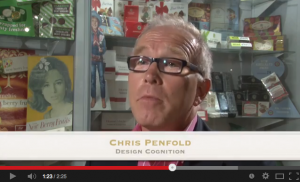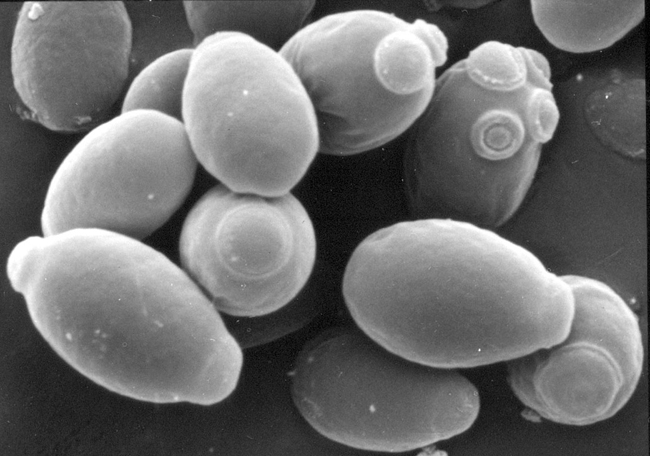You may recall that we recently went on a UKTI Trade mission trip to Los Angeles to better understand the potential of the US market. Hardly a ‘normal’ week for us, but we managed to capture events as we went along and here is our summary of a fantastic adventure that worked out really well for us and certainly raised our profile! Anyone that would like a job – ‘please apply within’  Chris
Chris
My Week: Chris Penfold, of Design Cognition
Published – Tuesday, November 24, 2009, from www.thisisbusiness-eastmidlands.co.uk/
Friday: Our company, Design Cognition, provides packing development and consultancy services to the pharmaceutical industry.
We have been thinking about exporting our skills and services to the US, which represents 40% of the global healthcare market, so a trade mission to the American Association of Pharmaceutical Scientists convention in Los Angeles seems an ideal route in.
Through UKTI, we manage to secure a free Club Class flight with BA – sadly only one. I fly ‘cattle class’ whilst our chief technical officer Annie Dallison enjoys the Club lounge, Champagne reception and a top-of-the-range bed. I sit with my bag of crisps, a bottle of water and a good book.
Arriving at Los Angeles airport we are greeted by a friendly character who directs us to the hotel shuttle bus and then announces that he is a volunteer collecting for the destitute and homeless of LA. We give him a small donation.
As we enter LA, the problem facing President Obama becomes ever more apparent as we see a number of homeless sleeping rough by the roadside. It’s obvious why donations for the destitute are needed. We certainly take our NHS service for granted. Despite its many faults, we can expect a certain level of care from a system which is the envy of the world.
Saturday: Our hotel is actually a ‘motel’ with a few extras such as a pond for a swimming pool. I get the Jacuzzi in my room and Annie doesn’t, so I feel slightly vindicated after the flight arrangements.
Sunday: After breakfast we catch up with George Canty of the East Midlands Healthcare and Bioscience iNet, who is representing UKTI. He will be helping us to meet potential customers, suppliers and partners and to discuss funding with investors.
We decide to spend today on the Pacific coast at Santa Monica and Venice Beach where tea and cake at the Tudor tea rooms includes a choice of any tea from around the world, including Typhoo and PG Tips.
The afternoon is spent at the LA Convention Centre where we set up the stand for the show.
The trade mission has involved a number of our BioCity Nottingham sister companies including Pharmaceutical Development Services and Food & Drink Analytical Services. We will be sharing stand facilities for the next few days.
This evening UKTI holds a networking meeting at the ‘Scottish Pub’ so we get to know the UKTI representatives in the US.
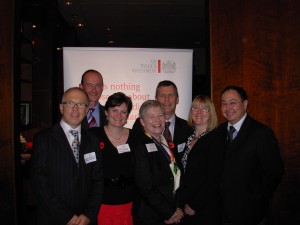
The team get to meet The British Consul General, Dame Barbara Hay
Monday: Still ‘Sleepless in LA’ with a 4.30am awakening. I’m finding difficulty adjusting to the eight hour time difference, so I use my time productively to catch up on emails and to press my crumpled suit.
The American Association of Pharmaceutical Scientists’ exhibition doesn’t start until 12.30. It is momentarily disrupted by animal rights protestors so security levels are high. The event gets off to a good start and we have a steady stream of visitors to our stand.
The purpose for our being here is to learn as much as possible about the US market and to assess how we might help US pharmaceutical companies to better understand European pharmaceutical packaging requirements and regulations.
Tuesday: A full day at the show is followed by an evening reception hosted by UKTI and the British Consul General, Dame Barbara Hay.
We are on the 54th floor of the Wells Fargo building with fabulous panoramic views of illuminated LA. Today is my 50th birthday so it is great to celebrate in style.
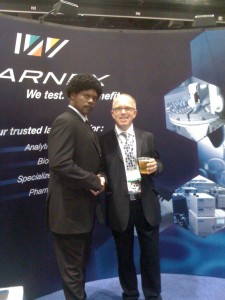
In a quieter moment we get to meet Samuel L Jackson
Wednesday
I manage to sleep in until 5am as my body continues to adjust. The third day and climax of the show is slower but we attract some potential leads.
Thursday
We leave for England today and everything seems to be going according to plan.
Annie makes the most of being amongst the privileged in the Club Class environment whilst I have another sandwich. Our expectations for this trip had been modest and we hadn’t expected to come back with a ‘shed full’ of orders, but we both agree that the trip has been invaluable.
You can read the ‘This is Business’ article here: LA Article
 Imagine a world where medical devices such as pacemakers could be implanted into the body, without the need for traditional batteries and cables and powered simply by body fluids. Well, it might not be as far away as you think. There have been some exciting and fascinating developments recently. Researchers have started to utilise a unique property of some materials, known as piezoelectricity, to generate electricity from kinetic energy….the same technology that is used in ‘wind-up torches’ to convert kinetic energy to electricity. Read more about this fascinating topic by following this link.
Imagine a world where medical devices such as pacemakers could be implanted into the body, without the need for traditional batteries and cables and powered simply by body fluids. Well, it might not be as far away as you think. There have been some exciting and fascinating developments recently. Researchers have started to utilise a unique property of some materials, known as piezoelectricity, to generate electricity from kinetic energy….the same technology that is used in ‘wind-up torches’ to convert kinetic energy to electricity. Read more about this fascinating topic by following this link.